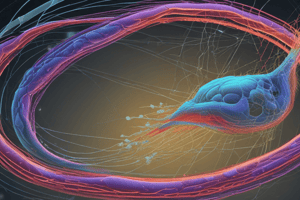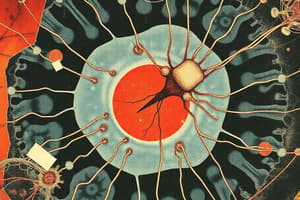Podcast
Questions and Answers
What are the three main components of the cytoskeleton mentioned?
What are the three main components of the cytoskeleton mentioned?
- Actin filaments, intermediate filaments, and microtubules (correct)
- Intermediate filaments, ribosomes, and actin filaments
- Actin filaments, chloroplasts, and microtubules
- Microtubules, endoplasmic reticulum, and lysosomes
Which organelle is primarily responsible for protein synthesis?
Which organelle is primarily responsible for protein synthesis?
- Mitochondria
- Golgi complex
- Lysosomes
- Ribosomes (correct)
What is the approximate thickness of the cell membrane?
What is the approximate thickness of the cell membrane?
- 10 nm
- 5 nm
- 7.5 nm (correct)
- 15 nm
Which structure is NOT found in the nucleus?
Which structure is NOT found in the nucleus?
What type of cell division involves the creation of gametes?
What type of cell division involves the creation of gametes?
Flashcards
Cell Membrane Thickness
Cell Membrane Thickness
The cell membrane is approximately 7.5 nanometers thick.
Virus Size Range
Virus Size Range
Viruses range in size from 20 to 200 nanometers.
Cell Organelles
Cell Organelles
Structures within a cell that perform specific functions.
Cytoskeleton Components
Cytoskeleton Components
Signup and view all the flashcards
Cell Cycle Stages
Cell Cycle Stages
Signup and view all the flashcards
Study Notes
Cell Structure and Function
- Cells are the basic unit of life, exhibiting a wide range of shapes and sizes.
- Transmission electron microscopy (TEM) images reveal internal structures like organelles.
- Cytoplasm is filled with organelles including ribosomes, lysosomes, mitochondria, etc.
- Heterochromatin is a structure within the cell.
Cell Components
- Cell membrane: Thin barrier (8 nm thick) that controls substance passage into and out of the cell, selectively permeable
- Endoplasmic reticulum (ER): Extensive network of membranous tubules and sacs.
- Ribosomes: Site of protein synthesis.
- Polyribosomes: Clusters of ribosomes on mRNA, creating multiple protein copies
- Golgi complex: Modifies and packages proteins for secretion or incorporation into cell membranes
- Lysosomes and Peroxisomes: Recycling centers for cell components.
Cell Fluid and Components
- Body fluids include blood, tissue fluid, and lymph.
- Intercellular/extracellular substances consist of fibrous proteins (collagen, elastin) and amorphous ground substances.
- Glycosaminoglycans: complex carbs + hexuronic acid + aminosugars
- Proteoglycans: Proteins + glycosaminoglycans
- Protoplasm: heterogeneous mixture of protein (%50), glycoprotein, proteoglycan, mucoprotein, and lipoprotein.
- Elements include hydrogen, oxygen, carbon, nitrogen, phosphorus, and sulfur
- Water is a component
Cell Types
- Eukaryotic cells are diverse in form and function.
- Different cell types have varying sizes, e.g., from 1-5 µm (bacteria) to 65 mm (hen's egg)
- Human red blood cells are 7-8 µm in diameter.
- Typical plant cell is 10-100 μm
- Chloroplast is 2-10 μm
- HIV virus is 100-500nm
Cell Size
- Molecular size ranges from 1 nm
- Smallest molecules, like hydrogen atom = 0.1nm
- Amino acid: 0.8nm
- DNA: 2 nm in diameter
Cell Membranes
- Plasma membrane separates cell contents from the exterior, controlling traffic (entry/exit)
- Selectively permeable; some substances pass more readily than others.
- Plasma membrane structure is a phospholipid bilayer (hydrophobic tails inward, hydrophilic heads outward)
- Includes embedded proteins (some permeate, others are surface proteins) and carbohydrates (glycoproteins & glycolipids).
- Membrane models (e.g., Davson-Danielli, Singer-Nicholson's fluid mosaic) depict the structure of the cell and its constituents.
Cell Transport
- Passive transport (without ATP): Diffusion, facilitated diffusion, osmosis.
- Active transport (using ATP): Ion pumps, endocytosis (pinocytosis, receptor-mediated endocytosis, phagocytosis), exocytosis.
Active Transport (Endocytosis)
- Pinocytosis: Uptake of interstitial fluid
- Receptor-mediated endocytosis: Specific receptors bind and uptake molecules
- Phagocytosis: Large particles like bacteria engulfed
Cell Transport (Exocytosis)
- Discharge of material from the cell, essential for releasing hormones/neurotransmitters/enzymes
- Vesicles fuse with the cell membrane to release contents
Signal Types
- Autocrine signaling: Cell signals itself.
- Paracrine signaling: Signals local cells.
- Endocrine signaling: Chemical mediators (hormones) carried in the blood to distant cells
- Direct signaling: a cell targets a neighboring cell through gap junctions
Organelles
- Specialized structures within the cell; create localized compartments, reactions
- Distinct pH or concentration levels for materials within, promoting specific cellular functions
- Membranes also host unique lipid-protein combos containing or embedding enzymes
Endoplasmic Reticulum
- ER: Extensive network of interconnected tubules, vesicles, and sacs.
- Rough ER: studded with ribosomes; makes proteins for export.
- Smooth ER: no ribosomes; synthesizes lipids, detoxifies chemicals, and stores calcium
Ribosomes and Polyribosomes
- Sites of protein synthesis.
- Free ribosomes create cytosolic proteins
- Bound ribosomes create export proteins bound to the endoplasmic reticulum
Golgi Complex
- Post office of the cell, modifying and packaging molecules.
- Modifies molecules by adding sugars/oligosaccharides.
- Sorts and directs molecules to specific destinations (export, membrane incorporation, other organelles like lysosomes)
- It has three membranous parts: cisterna, vesicles, and vacuoles.
Lysosomes and Peroxisomes
- Lysosomes: Recycling centers, organelles engulfing/digesting old organelles/bacteria
- Acid hydrolases, proteases, nucleases: breakdown several molecules by degrading nutrients/old organelles
- Peroxisomes: oxidative enzymes, breaking down amino acids, lipids, and detoxifying compounds.
Mitochondria
- Powerhouse of the cell, producing ATP (energy) via oxidative phosphorylation.
- Contains double bilayered membranes producing ATP
- Has special folded membranes (cristae) increasing surface area for ATP generation.
- Have their own DNA.
Nucleus
- Stores DNA, the genetic material of the cell
- Contains DNA replication and transcription to ribosomal RNA (rRNA).
- Regulates genome expression, coordinates cell activities
Nuclear Structure
- Nuclear envelope: Double membrane encloses the nucleoplasm.
- Nucleoplasm: viscous liquid surrounding chromosomes and nucleoli
- Nucleolus: Non-membraned, densely-staining region, containing ribosomal RNA (rRNA)
- Chromatin: DNA and associated protein, condensed into chromosomes
Nuclear Pores
- Channels in the nuclear envelope facilitating communication between the nucleus/cytoplasm.
- Protein complexes form the pores.
Chromosomes
- DNA + associated proteins (histones), condensed into visible structures
- Nucleosomes: Basic unit of chromatin, DNA wound around histone proteins
- Chromatin fibers, 30 nm fibers: Coiled structure of nucleosomes
- Chromatids: Duplicated chromosomes
Chromatin
- DNA+ protein complex; stores genetic material
- Heterochromatin: Condensed, inactive form of chromatin.
- Euchromatin: Less condensed, active form of chromatin
Cell Cycle
- A series of events, including growth, DNA synthesis, and division
- Processes include interphase (G1, S, G2), and the Mitotic (M) phase
- G1: growth
- S: DNA Replication
- G2: preparing for division
- M: Mitosis
- Mitosis: Division of DNA forming two nuclei
- Cytokinesis: Division of the cytoplasm
Three Cell Types based on Mitotic Activity
- Labile cells: Continuously divide, throughout life, e.g., bone marrow, epidermis
- Stable cells: Undergo limited division, respond to stimuli, e.g., liver cells, fibroblasts
- Permanent cells: Do not divide after birth/development, e.g., nerve cells, muscle cells
Cell Injury
- Reversible injury: Cell function affected, but eventually returns to normal.
- Irreversible injury: Cell death (necrosis or apoptosis) occurs.
Cell Death (Necrosis & Apoptosis)
- Necrosis: Cell death caused by injuries and inflammation
- Apoptosis: Programmed cell death, often necessary for normal development and function
- Features of apoptosis include condensation of chromatin, membrane blebbing, and phagocytosis.
Meiosis
- Cell division producing gametes with half the number of chromosomes
- Meiosis consists of two divisions (meiosis I and II) resulting in four haploid cells.
- Meiosis I is a reductional division halving the chromosome number; meiosis II is an equatorial division.
- Crossing over during meiosis creates genetic diversity
Errors in Meiosis
- Chromosome non-disjunction leads to aneuploidies (e.g. trisomy, monosomy)
- In trisomy, an extra chromosome is present; in monosomy, one chromosome is missing.
- Errors in meiosis contribute to genetic disorders and cancer.
Studying That Suits You
Use AI to generate personalized quizzes and flashcards to suit your learning preferences.



